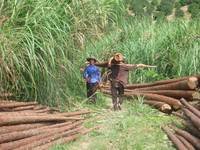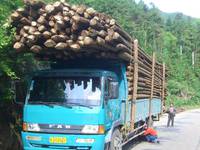


Background und Motivation
 |
 |
China has established 50 million ha of plantation forests including bamboo forests over the past 30 years (FAO 2005), equivalent to 25% of all global afforestation during that period. That large-scale land use change led to a remarkable increase in its national forest cover from 12% to more than 20%. In the framework of the current 12th Five-Year Plan (2011-2015), further substantial expansion of forest area and improvement of productivity as well as increase in average standing volume, resistance and stability of existing forests are formulated. By 2020, the forest area is planned to increase by 40 million ha (based on 2005 levels). The forest cover is aimed to reach 26% by 2050. The current average standing volume of the forests in China is only 71 m³/ha (FAO 2010), which is less than one fourth of that of 320 m³/ha in Germany (BMELV 2005).
The reforestation and afforestation initiatives in China can hardly be overrated in quantative terms, whereas the quality of young and middle-aged forest stands is relatively low. In genral, there exists large room to increase their productivity, stability as well as resulting ecosystem services with adapted concepts.
During the 10th Five-Year Plan period (2001-2005), the annual gap between average consumption of orest stock volume and domestic supply was nearly 200 million m³. It is predicted taht this gap will reach 300 million m³ by the end of 2010. China has thus become the world's largest importer of wood and wood products in the meantime. Owing to rapid economic growth on the one hand and limited resources on the other hand, innovative and sustainable strategies to provide renewable raw material are growingly required to be developed.
The actual relative low stocking in planted forests in China has to be seen against the background that most plantations were established on degraded land principally to restore or maintain important ecosystem services, such as water and erosion protection. It is therefore a result of less favarable site conditions, but also driven by a combination of short rotations with frequent site disturbances and by the lack of silvicultural concepts for long-term forest management.
Considering the existing impediments such as often difficult topography and lack of forest road infrastructure, the use of adapted wood harvesting techniques and modern technology such as cable winch system could offer possible solutions to the development of adapted utilization strategies. Moveover, an alternative wood utilization such as furhter processing of large dimention trees could give a positive impact on silvicultural possibilities.
In particular in southern china, the structural stability of the plantation forests with an average age between 20-40 years is not optimal. A piece of evidence for that is the devastating damage caused by snowstorms in January 2008. About 18 million ha of forests were destroyed within few days with an estimated economic loss of ca. 16 billion Yuan (1.6 billion Euro).
In Germany, multifunctional forest management strategies, which take expressly the stand stability against such damage into account, have been developed. One potential and often discussed adaptation strategy is “close to nature forestry” as a management principle, which is implemented as the guiding silvicultural principle also in the German Federal State of Lower Saxony (Partner State to Anhui Province; associated partner of this project) since 1990. A study on stand treatments, intervention types and tree species mixture is necessary in order to evaluate possibilities to convert even-aged pure stands into stable and multifunctional mixed stands.
Improvement or establishment of long-term sustainable forest management strategies is also a step toward the ambitious goals in regard to the reduction of net CO2 net emission China explicitly formulated in its actual 12th Five-Year Plan (2011-2015). In this context, a market mechanism for trading with carbon certificates is also planned to be established at national level. The enforcement of this process is highly dependent on the availability of generally accepted methods for forest biomass estimation. For the generation and valorization of eligible certificates, reliable estimates of carbon sequestration based on a statistically sound inventory and monitoring concept is as important as the establishment of a suitable trading system. Methodological approaches to the integration of remote sensing information and terrestrial inventory techniques are of high relevance in this context.



